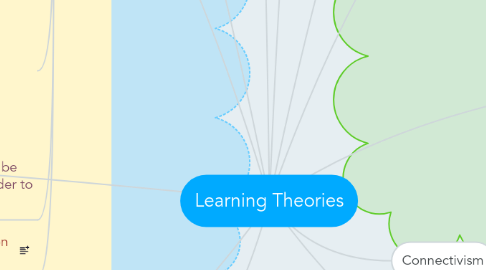Learning Theories
by Alexander Scully


1. Cognitivism
1.1. Study of the mind and how it obtains, processes, and stores information
1.2. Learners are active participants in their learning
1.3. The mind functions like a computer processor.
1.4. Information comes in as input.
1.5. The mind processes the information for the time being, and the information is stored away to be retrieved later
1.6. Learning is shaped by acquired learning strategies and prior knowledge and attitudes, called schemas
1.7. The cognitive view of learning is teacher-centered, and information must be presented in an organized manner in order to achieve the most efficient learning.
1.8. People learn better when they can build on what they already understand (Schemas).
2. Constructivism
2.1. Study of a learner's own construction of knowledge
2.2. Student's knowledge is constructed through his/her own personal experiences and interactions with the outside world.
2.3. The learner takes in new information and gives meaning to it using his or her own prior attitudes, beliefs, and experiences as references.
2.4. Learners are active participants in the construction of knowledge while the instructor serves as a facilitator
2.5. Social interaction with others helps the learner put meaning to information
2.6. Zone of Proximal Devleopment
2.7. Student develops greater level of meaning from interaction with other students and teacher.
2.8. Constructivist activities are generally relevant to the learner and real-world based
3. Implications for Education
3.1. Design presentations so slides are more visual instead of text heavy.
3.2. Practice for retention.
3.3. Use of mneumonic devices common
3.4. Use advanced organizers, mental maps and chunking so information is presented in meaningful chunks.
3.5. Concept maping is used.
3.6. Elextronic note taking, Prezi, Mindmeister, One note and Goodnotes are examples of programs used to support Cognitivism principles.
4. Course concept connections
4.1. Present information in meaningful chunks.
4.2. Concept mapping work well within the principles of Cognitivism.
4.3. Electronic note taking, goodnotes and Word track changes can be used by teachers an students.
4.4. Schema are memory structures written in Long Term memory by working memory.
4.5. Use instructional organizers and mapping to assist with chunking of material.
5. Implications for Education
5.1. Students monitor and direct their own learning and performance.
5.2. Concentration on Problem based learning.
5.3. Teacher acts as facilitator.
5.4. Project based learning is a key strategy and approach.
5.5. Lessons are designed around authentic task.
5.6. Discovery learning an case-based learning are included in the planning of lessons.
5.7. Collaboration between students, teachers, and the outside community helps make learning meaningful and connected.
6. Course concept connections
6.1. Learning by making includes hands-on activities and projects. Leads to the development of lessons that challenge students to use higher level thinking skills.
6.2. Gizmos and other simulations use to expand upon the foundations of previous learning.
6.2.1. Voice Threads, Animoto
